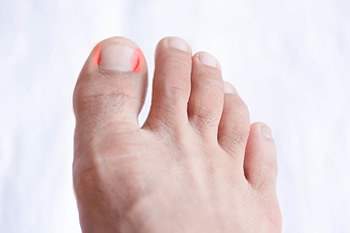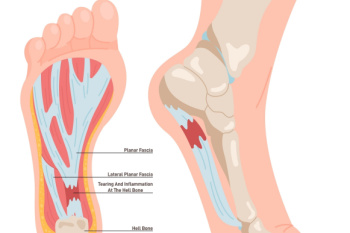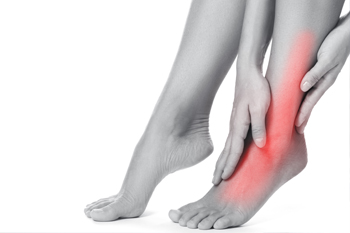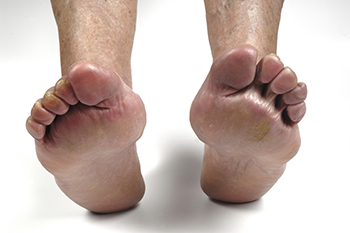Connect With Us
Blog
Items filtered by date: July 2025
How Negative Pressure Wound Therapy Helps Diabetic Foot Wounds Heal

People with diabetes mellitus face a higher risk of foot wounds that are slow to heal due to poor circulation and nerve damage, which can slow the body’s natural healing process. One treatment used by some podiatrists is negative pressure wound therapy. This method involves placing a special dressing over the wound and connecting it to a gentle suction pump. The controlled suction removes excess fluids and helps draw healthy tissue toward the wound to promote faster healing. Negative pressure wound therapy also reduces swelling and lowers the risk of infection. By keeping the wound cleaner and improving blood flow, this treatment encourages the body to repair damaged tissue more effectively. Some patients find that using this therapy helps their wounds heal more quickly than with standard treatments alone. If you have a diabetic foot wound that is not improving, it is suggested you schedule a visit with a podiatrist to explore your treatment options.
Wound care is an important part in dealing with diabetes. If you have diabetes and a foot wound or would like more information about wound care for diabetics, consult with Tanya R. Sellers-Hannibal, DPM from Maryland. Our doctor will assess your condition and provide you with quality foot and ankle treatment.
What Is Wound Care?
Wound care is the practice of taking proper care of a wound. This can range from the smallest to the largest of wounds. While everyone can benefit from proper wound care, it is much more important for diabetics. Diabetics often suffer from poor blood circulation which causes wounds to heal much slower than they would in a non-diabetic.
What Is the Importance of Wound Care?
While it may not seem apparent with small ulcers on the foot, for diabetics, any size ulcer can become infected. Diabetics often also suffer from neuropathy, or nerve loss. This means they might not even feel when they have an ulcer on their foot. If the wound becomes severely infected, amputation may be necessary. Therefore, it is of the upmost importance to properly care for any and all foot wounds.
How to Care for Wounds
The best way to care for foot wounds is to prevent them. For diabetics, this means daily inspections of the feet for any signs of abnormalities or ulcers. It is also recommended to see a podiatrist several times a year for a foot inspection. If you do have an ulcer, run the wound under water to clear dirt from the wound; then apply antibiotic ointment to the wound and cover with a bandage. Bandages should be changed daily and keeping pressure off the wound is smart. It is advised to see a podiatrist, who can keep an eye on it.
If you have any questions please contact our office located in Owings Mills, MD . We offer the newest diagnostic and treatment technologies for all your foot and ankle needs.
Understanding Ingrown Toenails

Ingrown toenails often start as a small nuisance but can quickly become painful and inflamed. This happens when the edge of a toenail begins to press into the surrounding skin, commonly on the big toe. Wearing tight shoes, poor grooming habits, and nail injuries are frequent causes. In some cases, there may be redness, swelling, or even drainage from the affected area. Early treatment may involve soaking the foot, keeping the area clean, and using over-the-counter ointments. When discomfort persists or infection develops, a podiatrist might need to trim or remove part of the nail. For recurring cases, a minor procedure to prevent regrowth of the offending nail edge can provide lasting relief. Outcomes are usually straightforward with timely care. Waiting too long can lead to deeper infections or skin complications. If your toe becomes sore, swollen, or sensitive to pressure, it is suggested that you see a podiatrist for evaluation and treatment.
Ingrown toenails may initially present themselves as a minor discomfort, but they may progress into an infection in the skin without proper treatment. For more information about ingrown toenails, contact Tanya R. Sellers-Hannibal, DPM of Maryland. Our doctor can provide the care you need to keep you pain-free and on your feet.
Ingrown Toenails
Ingrown toenails are caused when the corner or side of a toenail grows into the soft flesh surrounding it. They often result in redness, swelling, pain, and in some cases, infection. This condition typically affects the big toe and may recur if it is not treated properly.
Causes
- Improper toenail trimming
- Genetics
- Improper shoe fitting
- Injury from pedicures or nail picking
- Abnormal gait
- Poor hygiene
You are more likely to develop an ingrown toenail if you are obese, have diabetes, arthritis, or have any fungal infection in your nails. Additionally, people who have foot or toe deformities are at a higher risk of developing an ingrown toenail.
Symptoms
Some symptoms of ingrown toenails are redness, swelling, and pain. In rare cases, there may be a yellowish drainage coming from the nail.
Treatment
Ignoring an ingrown toenail can have serious complications. Infections of the nail border can progress to a deeper soft-tissue infection, which can then turn into a bone infection. You should always speak with your podiatrist if you suspect you have an ingrown toenail, especially if you have diabetes or poor circulation.
If you have any questions, please feel free to contact our office located in Owings Mills, MD . We offer the newest diagnostic and treatment technologies for all your foot care needs.
Plantar Fasciitis Facts

Plantar fasciitis is a foot condition caused by inflammation of the plantar fascia, the thick band of tissue that runs along the bottom of the foot. It often results from overuse, standing for long periods of time, or wearing shoes that lack adequate support. Risk factors include high arches, flat feet, obesity, and tight calf muscles. Symptoms include sharp heel pain, especially with the first steps in the morning or after long periods of rest. A podiatrist can provide relief through custom orthotics, footwear recommendations, and other treatments. If you experience ongoing heel pain or discomfort while walking, it is suggested that you promptly schedule a visit with a podiatrist for an accurate diagnosis and treatment options.
Plantar fasciitis can be very painful and inconvenient. If you are experiencing heel pain or symptoms of plantar fasciitis, contact Tanya R. Sellers-Hannibal, DPM from Maryland. Our doctor can provide the care you need to keep you pain-free and on your feet.
What Is Plantar Fasciitis?
Plantar fasciitis is the inflammation of the thick band of tissue that runs along the bottom of your foot, known as the plantar fascia, and causes mild to severe heel pain.
What Causes Plantar Fasciitis?
- Excessive running
- Non-supportive shoes
- Overpronation
- Repeated stretching and tearing of the plantar fascia
How Can It Be Treated?
- Conservative measures – anti-inflammatories, ice packs, stretching exercises, physical therapy, orthotic devices
- Shockwave therapy – sound waves are sent to the affected area to facilitate healing and are usually used for chronic cases of plantar fasciitis
- Surgery – usually only used as a last resort when all else fails. The plantar fascia can be surgically detached from the heel
While very treatable, plantar fasciitis is definitely not something that should be ignored. Especially in severe cases, speaking to your doctor right away is highly recommended to avoid complications and severe heel pain. Your podiatrist can work with you to provide the appropriate treatment options tailored to your condition.
If you have any questions, please feel free to contact our office located in Owings Mills, MD . We offer the newest diagnostic and treatment technologies for all your foot care needs.
What Causes Foot Pain?

Foot pain is a common issue that can affect people of all ages and activity levels. It refers to discomfort anywhere in the foot, including the heel, arch, sole, or toes. Common causes include injuries, gout, and verrucas, which are small, rough growths on the foot caused by the human papillomavirus, or HPV. Wearing poorly fitting shoes, and certain structural problems, such as bunions or hammertoes, also cause foot pain. Shoes that are too tight or lack support can create pressure and lead to chronic foot pain or deformities. Conditions like gout cause inflammation, while verrucas may bring sharp pain when walking. A podiatrist can evaluate the source of discomfort, offer treatments like custom orthotics, and provide guidance on proper footwear. If you have foot pain, it is suggested that you schedule an appointment with a podiatrist who can provide an accurate diagnosis and effective treatment solutions, restoring comfort and function to your daily life.
Foot Pain
Foot pain can be extremely painful and debilitating. If you have a foot pain, consult with Tanya R. Sellers-Hannibal, DPM from Maryland. Our doctor will assess your condition and provide you with quality foot and ankle treatment.
Causes
Foot pain is a very broad condition that could be caused by one or more ailments. The most common include:
- Bunions
- Hammertoes
- Plantar Fasciitis
- Bone Spurs
- Corns
- Tarsal Tunnel Syndrome
- Ingrown Toenails
- Arthritis (such as Gout, Rheumatoid, and Osteoarthritis)
- Flat Feet
- Injury (from stress fractures, broken toe, foot, ankle, Achilles tendon ruptures, and sprains)
- And more
Diagnosis
To figure out the cause of foot pain, podiatrists utilize several different methods. This can range from simple visual inspections and sensation tests to X-rays and MRI scans. Prior medical history, family medical history, and any recent physical traumatic events will all be taken into consideration for a proper diagnosis.
Treatment
Treatment depends upon the cause of the foot pain. Whether it is resting, staying off the foot, or having surgery; podiatrists have a number of treatment options available for foot pain.
If you have any questions, please feel free to contact our office located in Owings Mills, MD . We offer the newest diagnostic and treatment technologies for all your foot care needs.
Keep Your Feet Healthy So You Can Stay Active
Lifestyle Choices and Their Effect on Rheumatoid Arthritis in the Feet

Rheumatoid arthritis is an inflammatory condition that often targets the small joints in the feet and ankles. Certain lifestyle habits may influence both the development and progression of the disease. Smoking is linked to increased joint damage and may reduce the effectiveness of medication. Excess body weight adds pressure to the joints, increasing pain and limiting mobility. Staying active with low-impact exercise can help preserve range of motion and improve strength without adding stress. Wearing supportive footwear and cushioned insoles may ease discomfort during daily movement. Attention to stress levels, nutrition, and rest also plays a role in managing symptoms and maintaining joint health. If you are noticing pain, stiffness, or swelling in your feet and ankles, it is suggested that you schedule an appointment with a podiatrist for additional relief options.
Because RA affects more than just your joints, including the joints in your feet and ankles, it is important to seek early diagnosis from your podiatrist if you feel like the pain in your feet might be caused by RA. For more information, contact Tanya R. Sellers-Hannibal, DPM of Maryland. Our doctor will assist you with all of your podiatric concerns.
What Is Rheumatoid Arthritis?
Rheumatoid Arthritis (RA) is an autoimmune disorder in which the body’s own immune system attacks the membranes surrounding the joints. Inflammation of the lining and eventually the destruction of the joint’s cartilage and bone occur, causing severe pain and immobility.
Rheumatoid Arthritis of the Feet
Although RA usually attacks multiple bones and joints throughout the entire body, almost 90 percent of cases result in pain in the foot or ankle area.
Symptoms
- Swelling and pain in the feet
- Stiffness in the feet
- Pain on the ball or sole of feet
- Joint shift and deformation
Diagnosis
Quick diagnosis of RA in the feet is important so that the podiatrist can treat the area effectively. Your doctor will ask you about your medical history, occupation, and lifestyle to determine the origin of the condition. Rheumatoid Factor tests help to determine if someone is affected by the disease.
If you have any questions, please feel free to contact our office located in Owings Mills, MD . We offer the newest diagnostic and treatment technologies for all your foot care needs.

